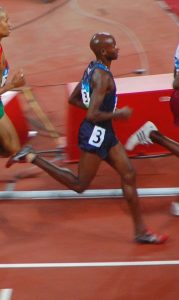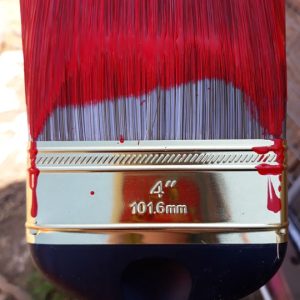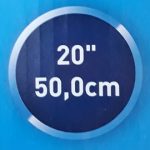1.3 Converting Length or Distance
Applications
Do you think of hiking or running distances in kilometers or miles? If you ran track in high school, you may very well think of distances in the metric system, as USA Track and Field switched to international units for competition decades ago. You are just a bit ahead of the rest of us!
Right now, the U.S. Geological Survey (USGS) is transitioning map products to the metric system. Scientific journals have required measurements reported in their papers in metric units for a while.

Some conversion ratios are exact, because a yard is defined to be exactly [latex]0.9144[/latex] meters, which means that a foot is exactly [latex]0.3048[/latex] meters and an inch is exactly [latex]2.54[/latex] centimeters.[1] The conversions that are not exact are rounded to four significant figures.
Conversion Factors for Length
[latex]1[/latex] in = [latex]2.54[/latex] cm
[latex]1[/latex] ft = [latex]30.48[/latex] cm
[latex]1[/latex] ft = [latex]0.3048[/latex] m or [latex]1[/latex] m [latex]\approx 3.281[/latex] ft
[latex]1[/latex] yd = [latex]0.9144[/latex] m or [latex]1[/latex] m [latex]\approx 1.094[/latex] yd
[latex]1[/latex] mi = [latex]5,280[/latex] ft
[latex]1[/latex] mi [latex]\approx 1.609[/latex] km or [latex]1[/latex] km [latex]\approx 0.6214[/latex] mi
Let's verify that [latex]1.98\text{ m}[/latex] is actually [latex]6\text{ ft }6\text{ in}[/latex]. We can start by writing [latex]1.98\text{ m}[/latex] as a fraction over 1 and then use the conversion ratio [latex]1\text{ ft}=0.3048\text{ m}[/latex] to cancel the units.
[latex]\frac{1.98\text{ m}}{1}\cdot\frac{1\text{ ft}}{0.3048\text{ m}}=\frac{1.98}{0.3048}\text{ ft}\approx6.49606\text{ ft}[/latex]
Rounding to three sig figs,[2] that's [latex]6.50\text{ ft}[/latex], which of course is [latex]6\text{ ft }6\text{ in}[/latex].
Let's verify that again using the approximate conversion ratio [latex]1\text{ m}\approx3.281\text{ ft}[/latex].
[latex]\frac{1.98\text{ m}}{1}\cdot\frac{3.281\text{ ft}}{1\text{ m}}=1.98\cdot3.281\text{ ft}\approx6.49638\text{ ft}[/latex]
Okay, everything looks good; both conversions give us a result that rounds to [latex]6.50\text{ ft}[/latex]. As long as we don't try to keep more than four sig figs in our result, we can use either conversion ratio and get the same result.
Examples: Conversions with Length
A) 5 km to mi B) 10 mi to km C) 15 cm to inches D) 1,500 cm to feet E) 1 mi to in
Practice Exercises
- In Canada, if a road in a city does not have a speed limit posted, the default speed limit is [latex]50\text{ km}[/latex] per hour.[3] Convert [latex]50\text{ km}[/latex] into miles.
- A Star Wars clone trooper is 6.00 feet tall. Convert this height to cm.
- An Olympic-size swimming pool is [latex]50.000[/latex] meters in length.[4] How many feet is this?
- A 4-inch paintbrush is labeled [latex]101.6[/latex] millimeters. Verify the accuracy of this conversion.

- An electric fan has an advertised diameter of [latex]20[/latex] inches, or [latex]50.0[/latex] centimeters. Verify the accuracy of this conversion.

- Is [latex]21[/latex] kilometers equivalent to [latex]13[/latex] miles?
Problem Set 1.3
-
Convert 2.3 miles to feet.
-
Convert 3,400 meters to miles.
-
Convert 4 meters to millimeters.
-
Convert 246,000 inches to miles.
-
Convert 1 mile to centimeters.
- Source: https://en.wikipedia.org/wiki/International_yard_and_pound ↵
- We round to three sig figs because the measurement 1.98 meters has only three sig figs. ↵
- Source: https://niagarafalls.ca/city-hall/transportation-services/traffic/speed-limits.aspx ↵
- Source: https://swimswam.com/how-big-is-an-olympic-sized-swimming-pool/ ↵

